#Clonmacnoise
Explore tagged Tumblr posts
Text

O'Rourke's Tower in Clonmacnoise, Offaly, Ireland
Irish vintage postcard
#postkaart#photo#postcard#photography#postal#Clonmacnoise#sepia#postkarte#briefkaart#vintage#carte postale#Irish#ansichtskarte#Rourke#ephemera#Ireland#historic#Offaly#Tower#tarjeta
42 notes
·
View notes
Text
The Airship of Clonmacnoise
Something so beautiful I read this year that gave me goosebumps - I want to record it here as we say goodbye to 2024:
***
The Celtic scholar Proinsias MacCana quotes an Old Norse text of the middle of the thirteenth century AD entitled Konungs Skuggsjá or 'King's Mirror'. It contains a number of legends or 'wonders', almost certainly based on oral traditions collected in the eastern part of Ireland, and reflecting tales which were first written down in Latin versions in the eighth or ninth century AD.
One such 'wonder' is set in the monastery of Clonmacnois where one day as the congregation was at Mass an anchor and rope were seen to come dropping from the air. The fluke of the anchor caught on the church door and, on looking up, the people saw a ship with men in it floating in the air. A man leapt overboard and dived down towards the anchor, moving his hands and feet as if he were swimming. As he tried to loosen the anchor some of the people on the ground wanted to restrain him, but the bishop, who happened to be present, prevented them, saying that if they did so the man would die just as if kept beneath water. And so the man was released and regained his ship where the crew cut the rope and sailed away.
This legend, as with so many manifestations of Celtic mythology, as MacCana has pointed out, adds a sense of ambiguity, an extra dimension where time and space no longer form the natural boundaries of rational relationships... (source Celtic Art by Ruth and VIncent Megaw)
***
More on The Airship of Clonmacnois here. I was also reading Faeries by Alan Lee and Brian Froud and there is a similar mythological story in there where one sees something as the sea, while someone else sees it as sky above land.
A poet, Seamus Heaney, was entranced by the Clonmacnois story too, seeing it as: “a kind of dream instruction, a parable about the necessity of keeping the lines open between the two levels of our being, the level where we proceed with the usual life of the meeting and the decision, and the other level where the visionary and the marvellous present themselves suddenly and bewilderingly. We must, in other words, be ready for both the routine and the revelation. Never be so canny as to ignore the uncanny.”
#celtic#mythology#parallel dimension#interdimensional#Otherworld#wonder#celts#ireland#Konungs Skuggsjá#Clonmacnoise#Airship of Clonmacnoise
3 notes
·
View notes
Text

St. Ciaran’s Church, Clonmacnoise, Ireland by the River Shannon. May, 2012
EST. 545 AD. Over the centuries, local farmers would take teaspoons of blessed soil from around the foundation, hence the slump!
3 notes
·
View notes
Text

"OPW must reopen shop at Clonmacnois" by Nuala Holloway is a plea for Ireland's Office of Public Works to reopen The Shop At Clonmacnoise, to show respect to the visitors of this world famous Irish heritage site and to stop taking away jobs including the staff and manufacturers of products which include independent writers and craftspeople.
Printed in The Westmeath Independent (3/5/2025)
www.nualaholloway.com
0 notes
Text
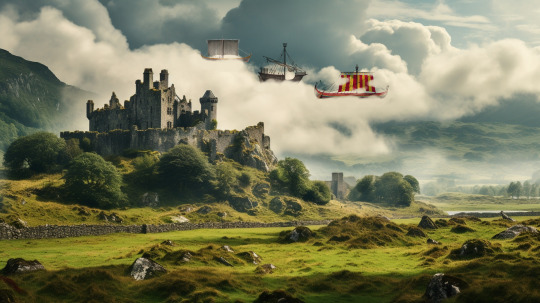
Les naus volants de Cluain Mhic Nóis.
#art#art digital#fotomuntatge#nau volant#Cluain Mhic Nóis#Clonmacnoise#paranormal#nau aèria#màgic#oníric#realitat daimònica#daimònic
1 note
·
View note
Text

"Elvis and Ireland" by Ivor Casey is now available to buy at The Shop at Clonmacnoise, Co. Offaly.
This critically acclaimed and internationally celebrated biography is a social study and historical document of Elvis, his life and influence during a very different time in Ireland and the birth of Irish rock 'n roll culture with quotes, facts and interviews from some of Ireland's greatest names in music.
1 note
·
View note
Text
Clonmacnoise Monastery – Cluain Mhic Nóis | 'Meadow of the Sons of Nós'
This monastery is situated on the banks of the Shannon, it was founded in 544 AD by St Ciarán on a fertile meadow, or cluain, surrounded by bog. It could be reached only by river or along esker ridge known as the pilgrim’s road. The monastery flourished for 600 years as a centre of learning and religious instruction. It also supplied much of Ireland’s finest Celtic art and illuminated manuscripts…
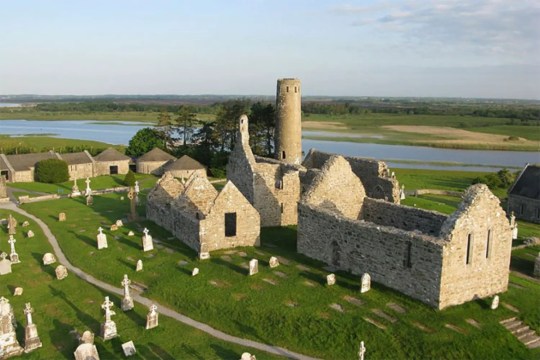
View On WordPress
#Clonmacnoise Crozier#Clonmacnoise monastery#Cluain Mhic Nóis#Dervorgilla#Diarmait Mac Murchada#Dublin#History#History of Ireland#Ireland#Irish#Irish History#Lebor na hUidre#Meadow of the Sons of N��s#National Museum#Normans#Shannon River#St Ciarán#Strongbow#The Book of the Dun Cow#Tiernan O&039;Rourke#Vikings
19 notes
·
View notes
Text

Saint Ciarán of Clonmacnoise (St. Ciarán or Kieran the Younger) 516 AD - 546 AD Feast Day: September 9th Patronage: Connacht
Saint Ciarán of Clonmacnoise, (sometimes called Ciarán or Kieran the Younger to distinguish him from the 5th-century Saint Ciarán the Elder who was bishop of Osraige), was an Irish saint and abbot whose miracles provided food for many in a time of famine. He was one of the Twelve Apostles of Ireland and the first abbot of Clonmacnoise.
Prints, plaques & holy cards available for purchase here: (website)
46 notes
·
View notes
Text
Identifying J.C. Walker's Illustrations
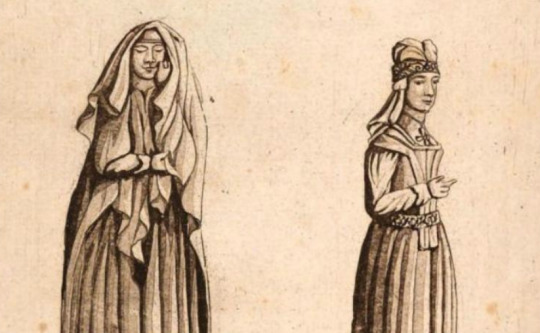
An Historical Essay on the Dress of the Ancient and Modern Irish by Joseph Cooper Walker published in 1788 was the first major work published on Irish dress history. Due to a combination of the limited information known at the time, and his erroneous assumption that Irish dress didn't change for the entirety of the Middle ages, Walker got a lot of things wrong, so his writing isn't cited much anymore. Some of his illustrations, however, are still used.
Because Walker lived before the invention of photography, he used drawings of historical Irish art created by colleagues and family to illustrate his book. I decided to track down the original works of art to see how Walker's drawings compared. I am resorting these into roughly chronological order, because Walker's lack of regard for chronology makes my head hurt.
The High Crosses, 9-10th centuries:
Ireland's high crosses have unfortunately lost a lot of their detail due to erosion, making these hard to identify. Sadly, the breeches with a fitted knee-band and the skirt gathered to a waistband look more Late Medieval or Early Modern than they do Early Medieval, so I don't think these are reliable depictions of the lost detail.
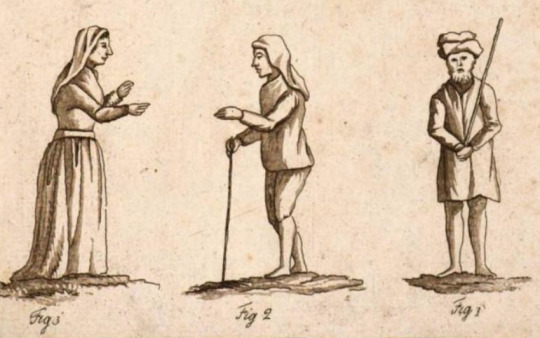
Plate 1: Figure 1 (right) is supposed to be from the Clonmacnoise Cross of Scripture. At a guess, it's based off the guard on the right arresting Jesus:
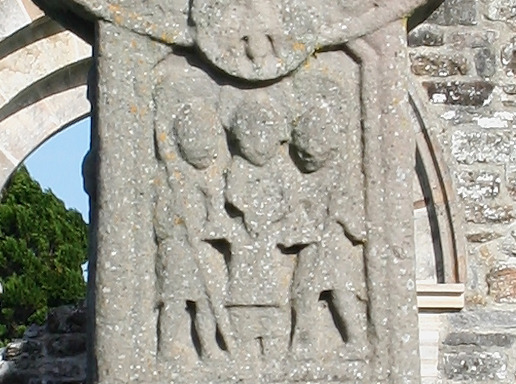
Figures 2 and 3 are based off a high cross fragment at Old Kilcullen, County Kildare. Unfortunately, I don't think the original carving survived. I initially blamed its loss on the United Irishmen, but this drawing from 1889 convinced me that acid rain was the real culprit.
Plate 5 Figure 1 is supposed to be a king from Muiredach's cross. The closest image I could find on the actual cross is Cain killing Able:
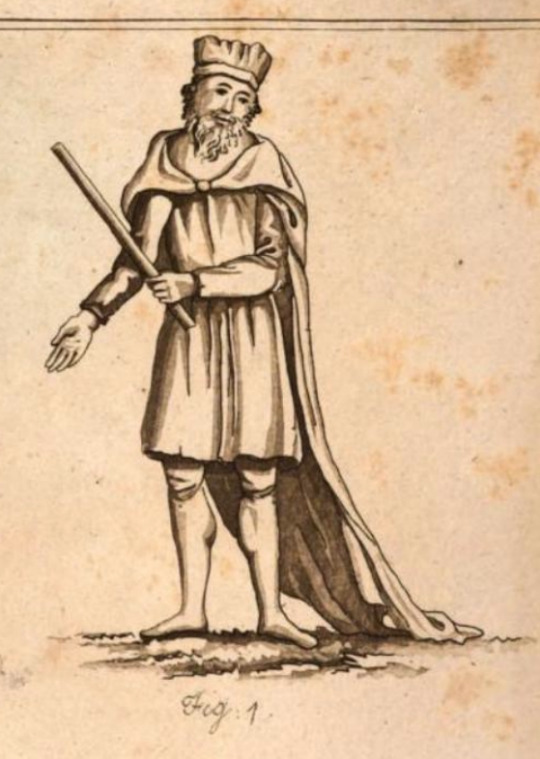
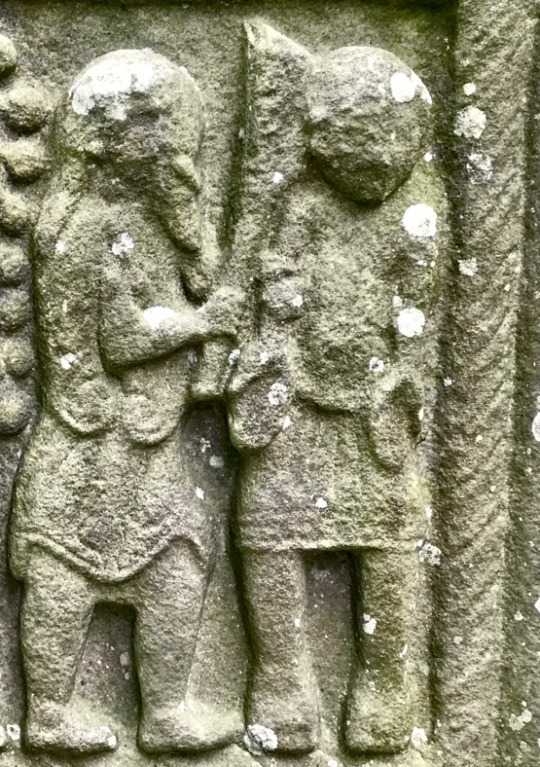
Ironically, Cain and Able have more embellishment on their clothes than the "king" based off of them.
12th century:
Plate 1 Figure 5 is from the capital of an arch at St. Saviour's Priory in Glendalough, County Wicklow. The drawing gives the impression that the sides of the head were shaved and the hair was deliberately curled at the end. In the actual carving, the hair is slicked back at the sides and interlaced with adjacent design elements. These are stylistic elements of Irish Romanesque art and not intended to be a realistic depiction of an Irish hairstyle.
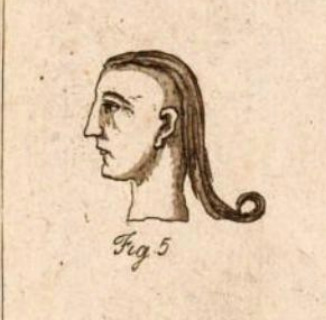

13th century:
Plate 4 is the late 13th century effigy of Felim O'Connor, Dominican Priory of St. Mary, Roscommon with a frontal of gallowglasses added in the 15th c.
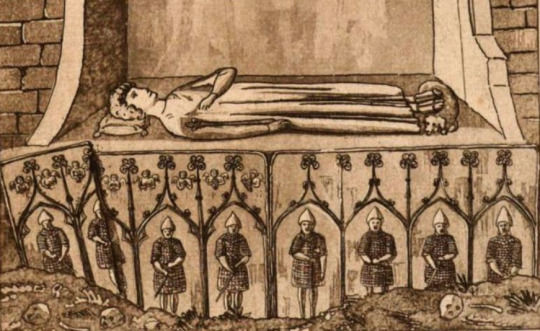
This drawing is pretty accurate, although the gallowglasses are lacking some details like their quilted cloth gambesons.

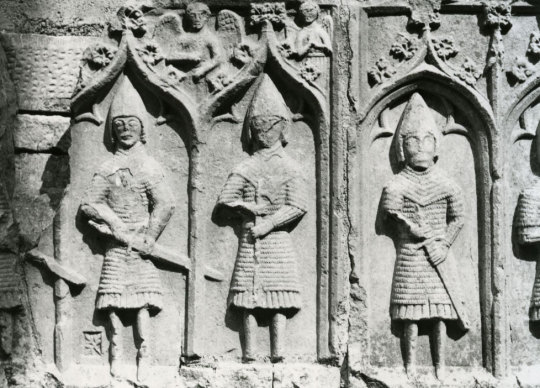
photos by Edwin Rae
I cannot find a good photo of Felim O'Connor's effigy, but Conor O'Brien's contemporary effigy at Corcomroe Abbey, County Clare wears the same style of clothing.
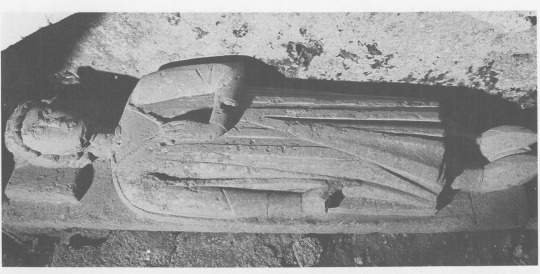
13-14th century?
Plate 6 is based on a sculpture from Athassel Priory in County Tipperary. I can't find a solid date for this one. Athassel Priory was built c1200 and then burnt and rebuilt twice before it was dissolved in 1541. The clothing style of the carving makes me think it's from the earlier part of this time frame.
The biggest thing the drawing gets wrong is the gender. This is a man, not a woman. The "necklace pendent" on his chest might have actually been a brooch holding his cloak, but the sculpture is now too damaged to tell. The drape of fabric at his side, which Walker calls a train, is actually the edge of his cloak. The drawing also leaves out the way his become more fitted below the elbow.
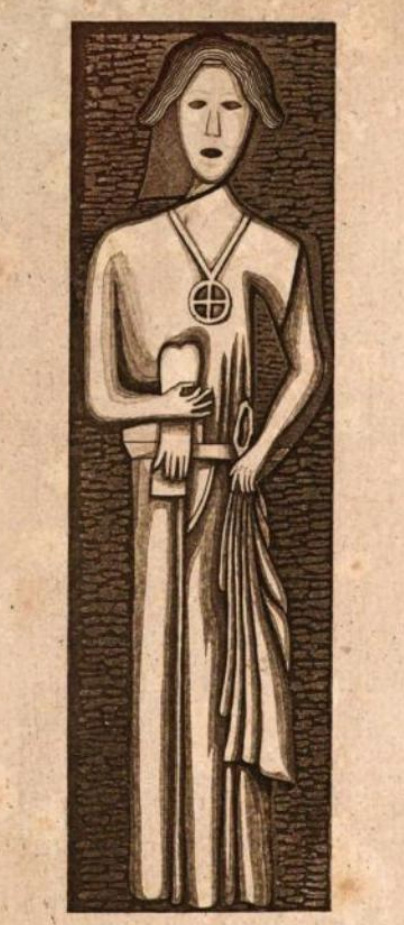
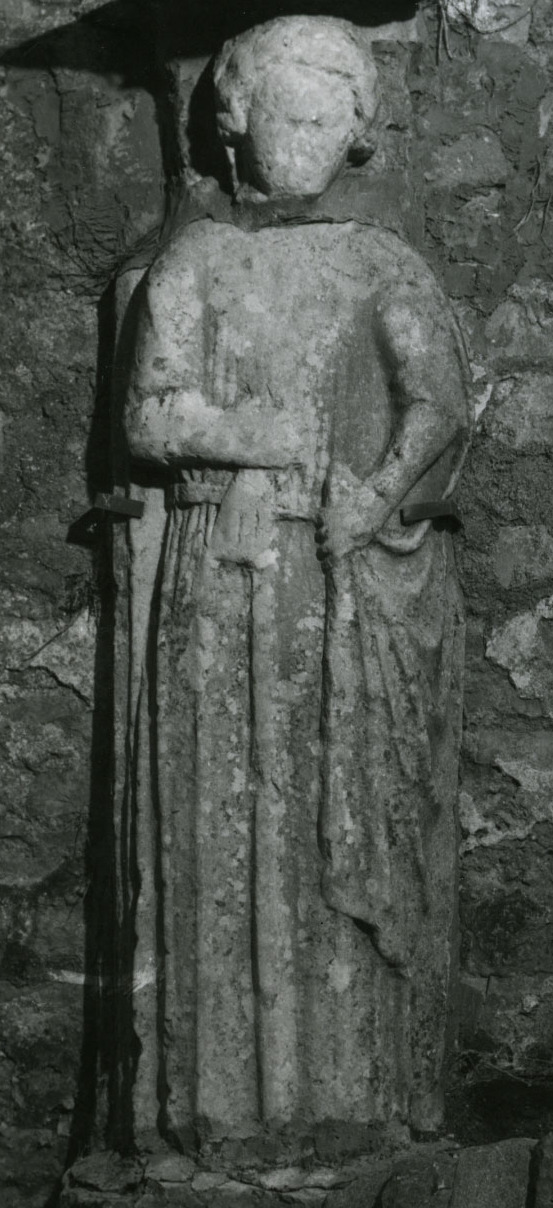
15th century:
Plate 3 Figures 1-3 are based off a painting at Knockmoy Abbey.
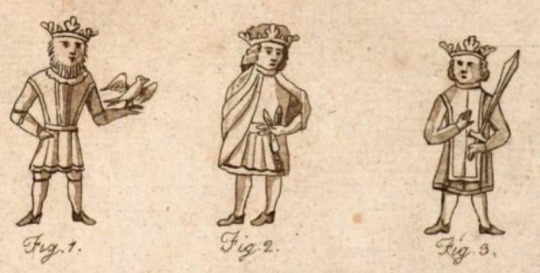
I'm pretty sure those are houppelandes on the left and center figures. This continental fashion influence shows up elsewhere in 15th c. Ireland (Dunlevy 1989). The drawing omits the massive houppelande sleeves and shortens their hems.
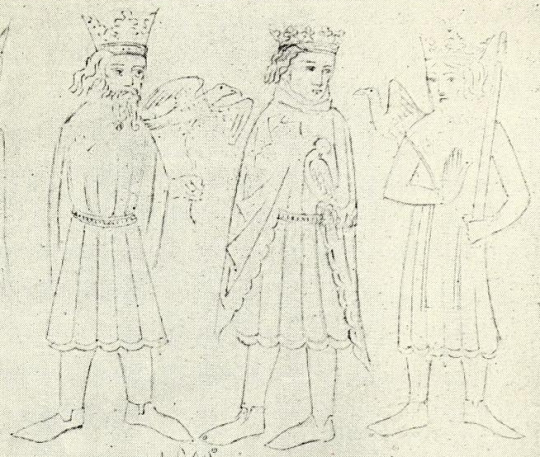
The painting is now badly weather and difficult to see. This is a more accurate drawing published in 1904. Recent photograph here
Plate 5 figure 2 and plate 1 figure 6 come from a 15th c. grave at the Dominican Friary, in Strade, County Mayo.
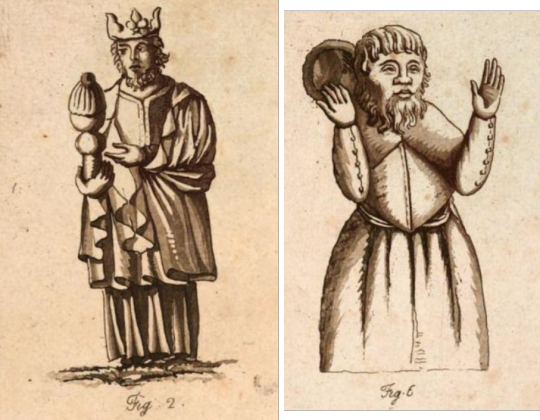
Figure 2 is a decent representation, although it adds a center front slit to the leine which I don't think is actually there. Figure 6 gets the silhouette of the cotehardie a bit wrong and omits the hanging belt accessories, but its greatest crime is that it makes the top of the hood look like a separate object. Walker actually misidenifies it as a Scotch bonnet.
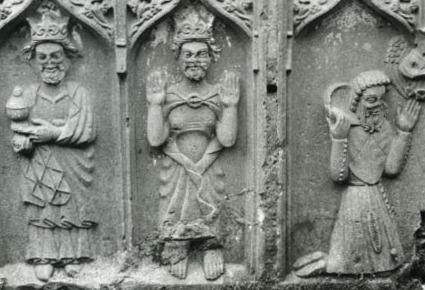
photo again by Edwin Rae
Plate 7 is Anne Plunket's effigy at St. Mary's Church, Howth, County Dublin. This drawing is decent, though the sleeves are a bit too slim. The cross necklace and belt decorations are no longer visible on the effigy.
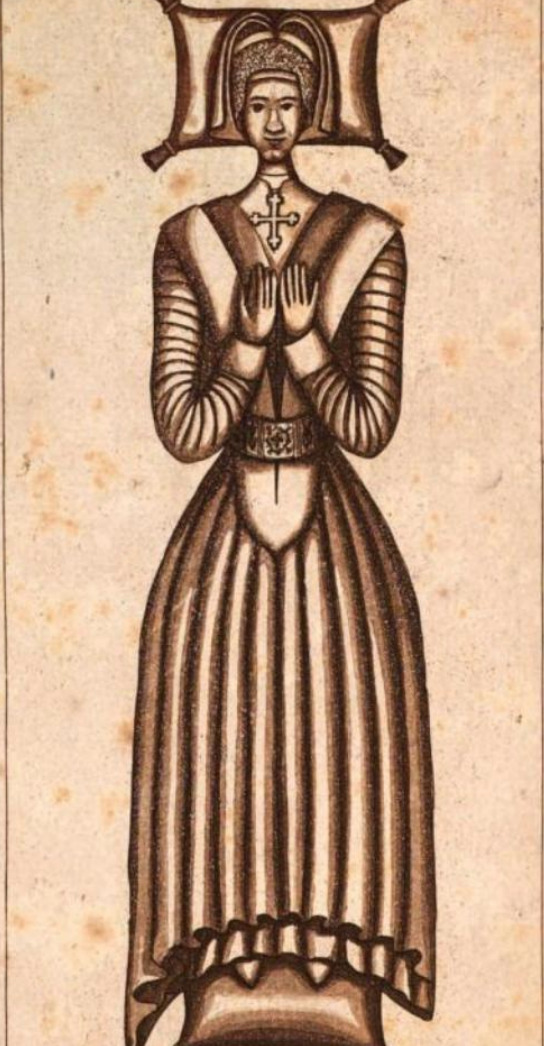
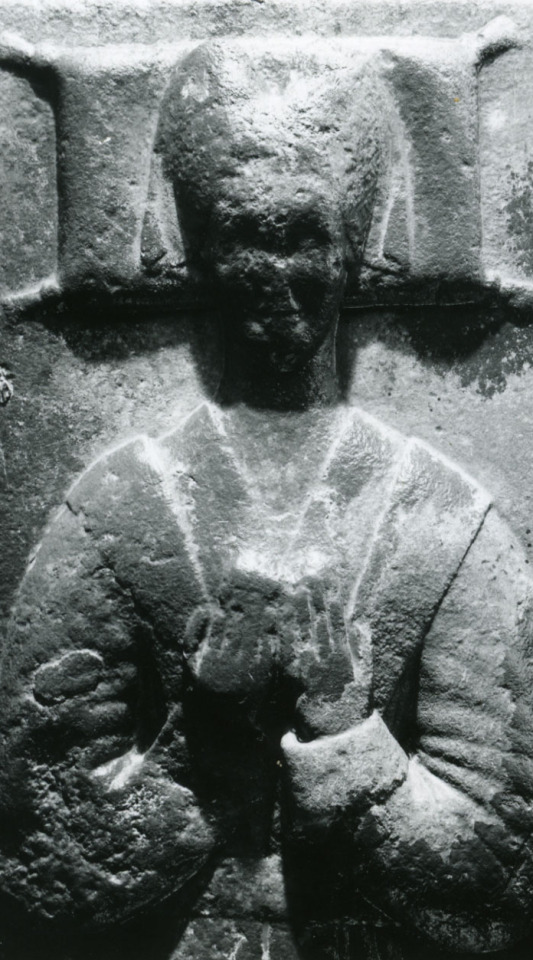
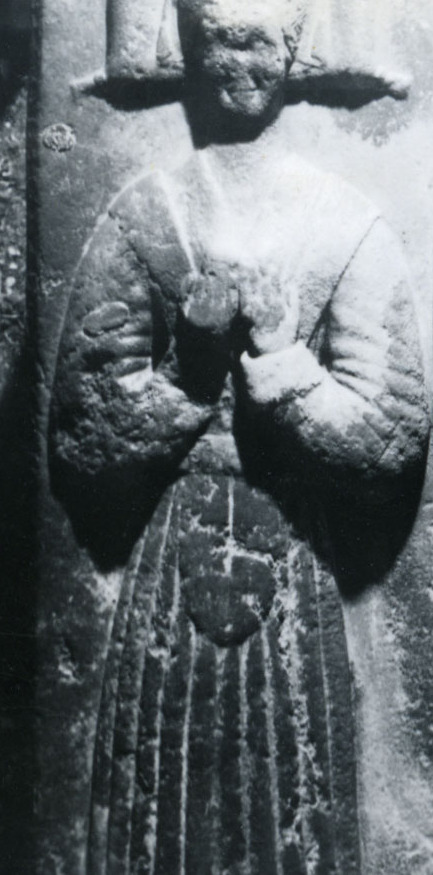
photos by MVP Edwin Rae
Plate 8 figures 1 and 2 are both based on a late 15th c. tomb at the New Abbey in Kilcullen, County Kildare. Figure 1 is based off a carving which is probably depicting St. Brigid, which makes her headwear the wimple of an abbess, not a laywoman's kerchief Walker. The drawing, however, omits her telltale crozier. The drawing makes it look like she has cuffed sleeves, but that is actually just the folds of her brat draped over her arm. It also shows her as wearing 2 layers of skirts when she is actually wearing a single lower garment with a hem circumference so large that it puddles at her feet.
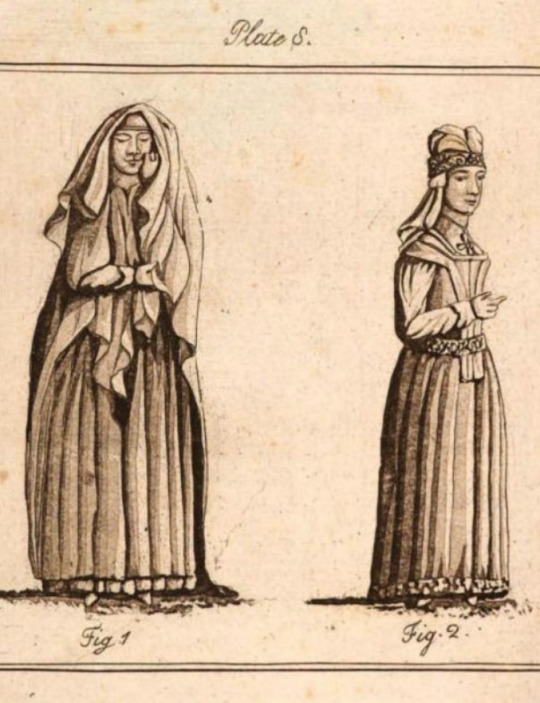

Figure 2 is based of Margaret Janico's effigy. The effigy is now too badly eroded to make out details, but it originally probably looked very similar to Margaret Janico's other effigy in St. Audoen's Church, Dublin. Unlike Anne Plunket's effigy above, the necklace and belt decorations are still faintly visible on the Dublin effigy. Figure 2 distorts the construction of the gown and headwear. This drawing makes the bodice of the gown look heavily stiffened or even boned like 17th c. stays. The houppelande on the effigy does not have stiffening in it.
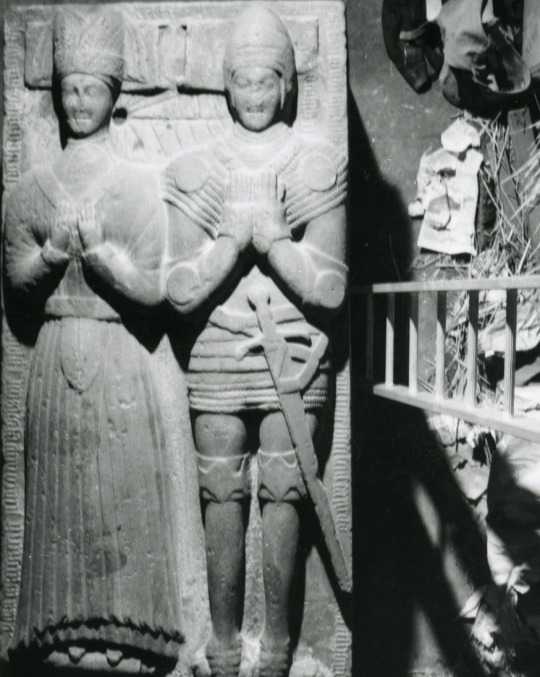
effigy of Margaret Janico and husband at St. Audoen's Church, Dublin (photos, once again, by my man Edwin)
The headpiece in the drawing looks like a linen kerchief wound up to form a turban with a decorated fillet tied over it. The headpiece on the effigy is probably actually a truncated hennin with a veil pinned to it like the one in this mid-15th c Burgundian painting by Petrus Christus.
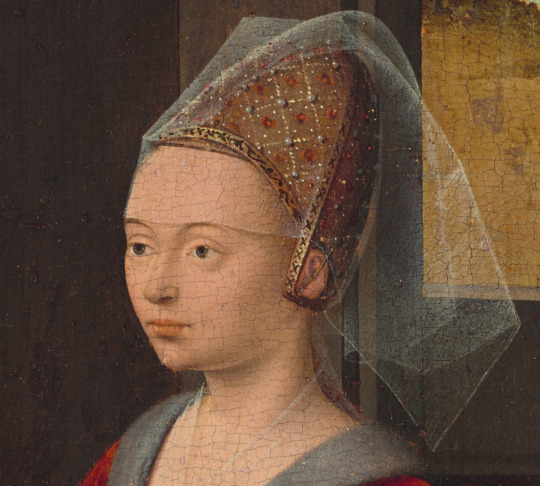
16th century:
Plate 9 is based on Katherine Molloy's early 16th c. effigy at Fertagh Church, in County Kilkenny. According to the artist's notes it was in "nearly perfect" condition at the time. I wish he had put more detail into the drawing.
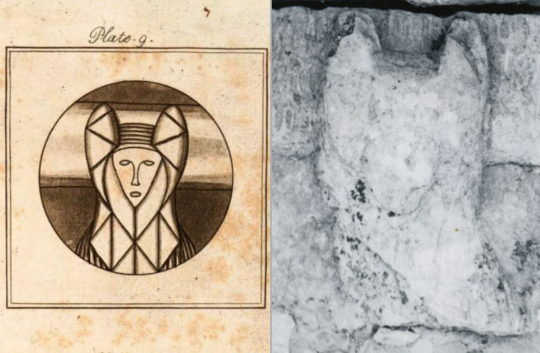
(photo also by Edwin Rae)
17th century:
Plate 10 is based on The Taking of the Earl of Ormond in anno 1600. Walker's artist clearly fabricated some detail here, falsely giving the impression that triús were ankle-length. We know from extant examples from Kilcommon, Dungiven, and Killery that triús actually extended past the ankle, covering part of the wearer's foot (Dunlevy 1989, Henshall et al 1961).
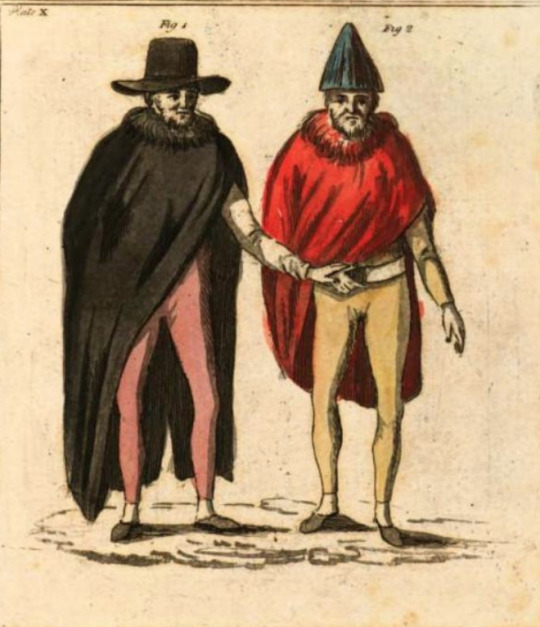
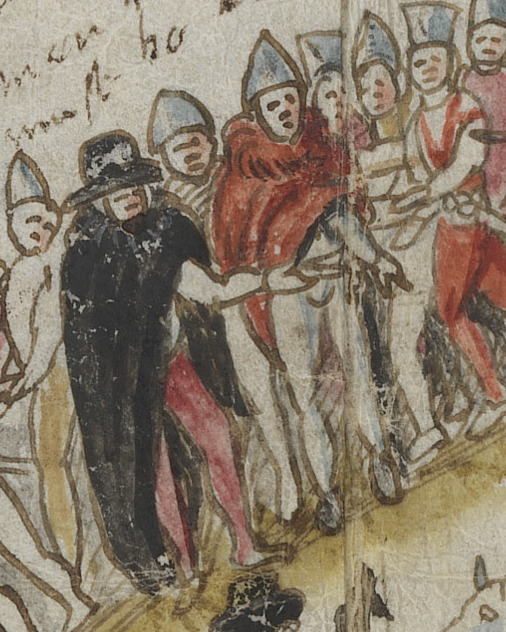
Plate 11 was taken from the tomb of Sir Gerald Aylmer (died 1634) and Juliana Nugent. Sadly, it appears to have been destroyed in the early 19th c, so I have no further pictures of it. The clothing looks to me like typical 1630s English fashion with loose gowns over doublets, falling bands, and linen cuffs.
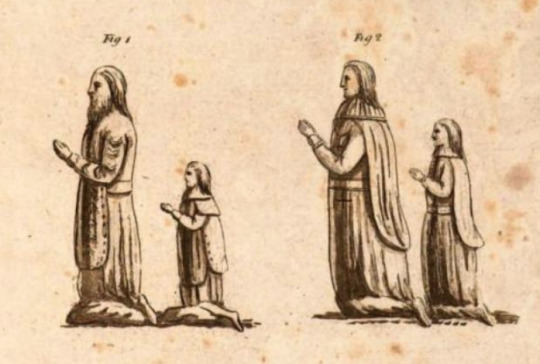
? Century
Plate 1 figure 4 is apparently from Old Kilcullen, County Kildare. I am not sure what this is based on. I haven't seen any Santa hats at Old Kilcullen. Or anywhere else in Medieval Ireland.
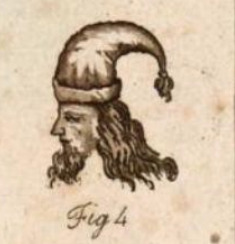
Bibliography:
Dunlevy, Mairead (1989). Dress in Ireland. B. T. Batsford LTD, London.
Henshall, Audrey, Seaby, Wilfred A., Lucas, A. T., Smith, A. G., and Connor, A. (1961). The Dungiven Costume. Ulster Journal of Archaeology, 24/25, 119-142. https://www.jstor.org/stable/20627382
Edwin Rae's invaluable collection of photographs of Late Medieval Irish art accessed via TARA.
#15th century#irish dress#dress history#irish history#art#early medieval#16th century#historical women's fashion#historical men's fashion#historical fashion#hiberno norman#gaelic ireland#headwear
16 notes
·
View notes
Text
Dairthech, Clonmacnoise, Co.Offaly
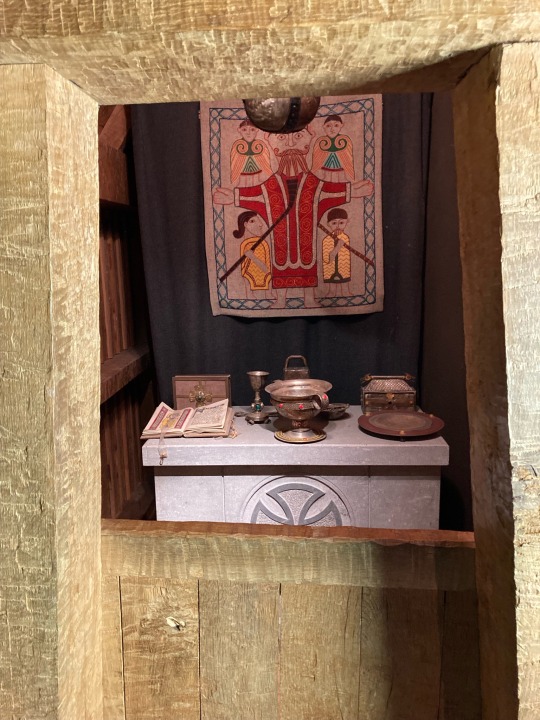
In Gaelic Ireland, between the 5th and 9th centuries AD, a dairthech (literally "oak-house") was a type of oratory or church built of oak-wood. This is a reconstruction of a dairthech, a typical small oak church, such as the ones that may have stood at Clonmacnoise prior to their reconstruction in stone.
25 notes
·
View notes
Note
Could I have a name appraisal on the name Kieran?
How does it feel to be named after Saint Ciarán of Clonmacnoise?
8 notes
·
View notes
Text

At the banks of the River Shannon you will find the beautiful Clonmacnoise. Sitting in the center of Ireland, it is a must for history lovers!
📍 County Offaly
Credit Tourism Ireland.
Love Ireland
4 notes
·
View notes
Text
Saturday, April 19 - Ennistymon to Kilkee










It was lightly raining when we finished our wonderful Irish breakfast, but the wind had let up and it was a few degrees warmer than yesterday. Our next lodging was only about 45 kilometers away if we had gone directly, but we had other plans. We headed instead back over to Kilfenora, where the Burren Centre is located, and this time actually wandered around the town, seeing their old church and a collection of high crosses that were found around the town. These Irish high crosses date from the late 11th or early 12th century, and several of them have the typical elements of the circle and arms that are found in almost all high crosses. Usually there is a crucifixion scene on one side, and some elements of Christ's life - these were often for teaching the illiterate about the Bible, often with an emphasis on heaven and hell. The other side usually features a local saint - often the bishop or other important figure in the history of the local church. Here there are also usually more stories. Often these scenes are interspersed with detailed Celtic knots and other symbology. None of these crosses were as detailed as the ones we had seen at Clonmacnoise, but they were still impressive. The wall hanging is an artist's impression of the carving of one of the high crosses located here.
We headed east to another cluster of buildings called Dysert O'Dea, where there was a church with an intricately carved door frame with lots of faces. This doorway dates from the 12th century, and was incorporated into the now-ruined church built 3-4 centuries later. A round tower, blasted by Cromwell's forces is close by, too. In the field in front of the church is another high cross - this one is unique in that the carving of the bishop on one side was constructed so that one of his arms could be removed. Unfortunately, it has been removed permanently, as it disappeared a long time ago.
We then headed back west towards Kilkee, and although it never rained all that heavily, it was still misty and cool most of the drive. We stopped at a beach part way down the coast - there was a "surf school" operating and it was fun to watch the would be surfers try to catch waves and stand up. Most of them were doing pretty well. The rocks here were interesting, with lots of cockle shells and seaweed decorating them at low tide.
We arrived in Kilkee at the perfect time to check in, dropped our bags and headed back into town to find some parking for a walk along the cliffs. Kilkee is centered around a lovely crescent shaped beach, and since this is a holiday weekend, the place is fairly crowded. Not that anyone was bathing - rather it was bundled up beach walking or hiking the path up to the cliffs.
The cliffs here are not as high as at Moher, the most famous cliffs in Ireland (which we decided to skip), but are quite spectacular, and far less crowded. The wind had picked up a bit, but the rain held off, and because of the later hour, we had the place mostly to ourselves. Before one comes to the cliffs proper, there are the "diamond rocks", which are flat but have a criss-cross pattern of cracks. Some people walked a great ways out on them - we found them a bit slippery after the rain, so just headed uphill, and were rewarded with great views, at least as far as we could see in the mist.
Notes on some of the pictures. The "rump International" golf course is not that far from our current town - I couldn't resist taking a picture of what the locals seem to think. And the fields around Dysert O'Dea were filled with sheep, and we had to be very careful where we walked. Unlike in Wales or Cornwell, where a flock will either be all of a kind, whether all white, or black-faced, or all black, here in Ireland every flock we have seen has all varieties all jumbled up. The painting of the sheep band was in Kilfenora - it was too bad that it was missing the fiddler sheep.
Tomorrow we plan to head down to the end of the Loop Head Peninsula (where we are now) and see a couple of lighthouses, as well as more cliff scenery and walks. There's no real rain in the forecast, but it will be cloudy, so photography will be less than optimal. We'll just be happy not to have to wear our rain pants.
0 notes
Text
vimeo
Clonmacnoise Historical AR App for iPad - Paul Smith
0 notes
Text
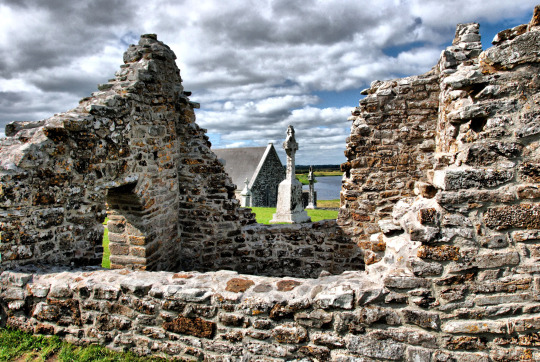
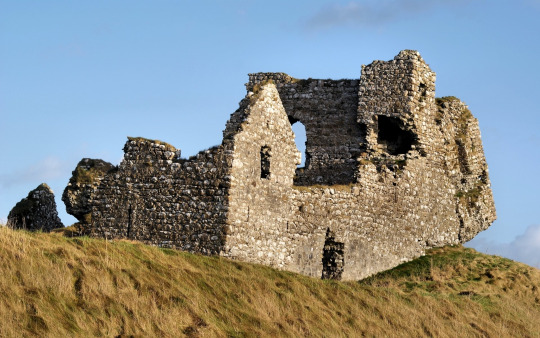
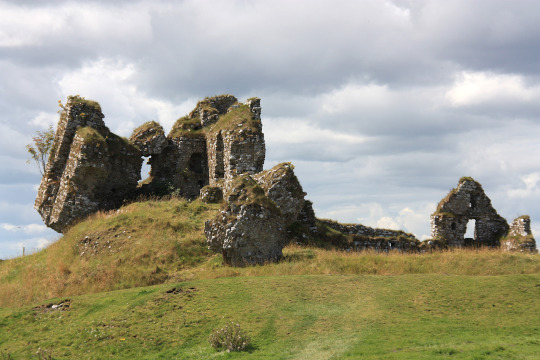
Les ruïnes del monestir i del castell de Clonmacnoise (Cluain Mhic Nóis, en gaèlic irlandès), al centre d'Irlanda.
1 note
·
View note
